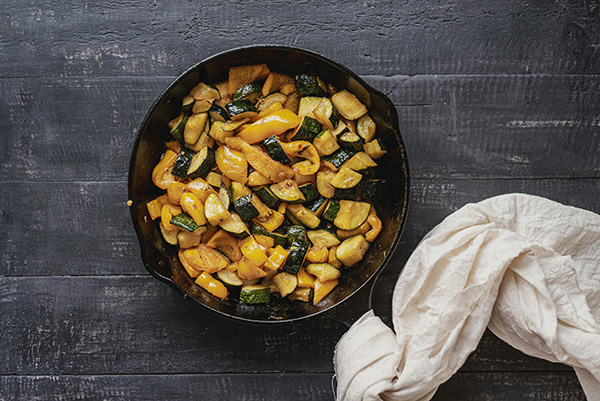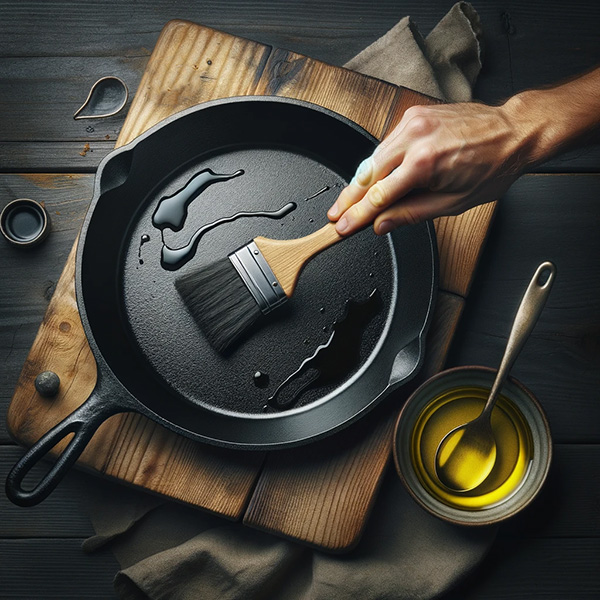If you've ever tried to use cast iron cookware and given up because all of the food seemed to stick, let me give you a tip - it's the seasoning! Cast iron is an incredible surface for cooking and baking, but it needs to be properly seasoned. Even pans sold as "pre-seasoned" need a couple of rounds of additional seasoning to get that nonstick finish!
Does it sometimes feel like we're using unfamiliar terminology? What exactly does it mean to "season" a skillet? Why is this process significant? How do you season a cast iron skillet properly? Don't worry; the information below covers all your queries about cast iron.
What Is Cast Iron Skillet "Seasoning"?
When we talk about cast iron "seasoning," we're referring to the layer of carbonized oil baked into the cookware surface to create a nonstick cooking surface. Seasoning is commonly used with cast iron and carbon steel pans to enhance their performance and longevity.
When fats and oils are heated to very high heat in a cast iron pan, they become molecularly bonded to the iron through a process called polymerization. As the layers of seasoning build up, the texture is filled in, resulting in a smooth, almost glassy cooking surface. This is the classic black patina we want on our cast iron skillet! The layers of carbonized oil create an easy-release cooking surface that rivals Teflon!
This seasoning process can happen naturally through the regular use of your skillet. Over time, the oils and fats used in typical cooking will adhere and polymerize, resulting in a nonstick protective coating. However, most cast iron users would prefer not to wait for this to happen!
Instead, you can purposefully season cast iron using the method below. A pan's first initial seasoning should occur over multiple consecutive rounds. The key is many thin layers of carbonized oil! Don't rush it!
What Is The Best Oil To Use To Season Cast Iron Skillet?

Learn what is the best oil to season a cast iron skillet is an important part of the cast iron skillet experience. The term cast iron "seasoning" is essentially nothing but carbonized oil. What type of oil should be used?
Many cat iron skillet users have their particular preference, but any neutral cooking oil will work as long as it has a smoke point of at least 400 degrees Fahrenheit. An oil's term "smoke point" indicates the temperature at which it begins to emit smoke. You need to bring the oil to its smoke point (if not higher) and keep it at that heat for the polymerization.
Good neutral oils are grapeseed oil, sunflower oil, and safflower oil. Some cooks prefer flaxseed oil, peanut oil, and olive oil as they create a very hard seasoning. However, it has a low smoke point. Other cooks will use various solid animal fat, such as lard, ghee butter, or tallow. While these create a great seasoning, they are not flavorless fats and will give a taste to your cooking.
I tend to avoid vegetable oil and canola oil due to their highly processed characteristics. They are typically extracted with chemical solvents, followed by refining, bleaching, and deodorizing processes. This extensive processing raises health concerns regarding the consumption of these oils.
How Often Do I Need To Reseason A Cast Iron Skillet?
There's a sense in which you're reseasoning your cast iron cookware every time you use it and how to clean the cast iron skillet after each use. However, you might notice that the glassy black patina is starting to wear off. This happens most quickly if you tend to cook acidic foods. If this is the case, it's time for a thorough oiling and heating process. Some cast iron skillet companies, such as Lodge Cast Iron, suggest reseasoning your skillet once or twice a year.
How To Season A Cast Iron Skillet

Clean The Skillet
You need the oil to bond with the iron, and it can't do that if there's food residue in the way. The initial stage in seasoning a cast iron pan involves ensuring its thorough cleanliness. You may have heard you should avoid washing your pan with dish soap, as it can degrade the seasoning. However, you're about to put fresh seasoning on it! So go ahead and scrub your pan in soapy water and then dry it using a towel or place it over low heat.
If you are cleaning a cast iron pan with sticky gunk, stuck-on food, and residue, you can try to use steel wool or scrub brush to clean. However, steel wool will strip the pan completely. Dip the steel wool in warm, soapy water and gently scrub the areas with stuck-on food or residue. Use light pressure and circular motions. Avoid using excessive force, as too much pressure can scratch the skillet. Prior to reseasoning, make certain to rinse and dry the skillet thoroughly.
Dry The Skillet Thoroughly
Cast iron and water are not friends. Once you have your pan washed, dry it thoroughly. Pretend that you are allergic to water. Get all of it dried off. A great way to do this job thoroughly is to put it on an over burner and let the heat evaporate any excess moisture. Then, allow it to cool before proceeding to the following step.
Rub Oil Into The Pan
Add a small (small!) amount of oil to the cast iron pan. Employ a cloth or paper towel to evenly spread the oil across the pan's interior and exterior. Don't forget the handle! New cast iron users often use too much oil to season their cast iron pans. Remember that you're rubbing the oil into metal, not a sponge. It can only soak up so much. After thoroughly applying the oil, utilize a dry cloth or paper towel to eliminate any excess oil.
Heat The Skillet
Preheat your oven to a temperature ranging from 400 to 500 degrees Fahrenheit. Position a sizable baking sheet or a layer of aluminum foil on the lower rack of the oven to catch any drips.
Next, position your skillet upside down on the upper rack of the oven. This positioning prevents any surplus oil or liquefied shortening from accumulating at the pan's base. Instead, it will drip away, and you will want a catch-drip tray at the bottom to catch any excess oil! Leave the cast iron skillet to "bake" in the hot oven for at least one hour.
Let The Skillet Cool
Turn off the oven and let your seasoned cast iron pan cool slowly. This can take quite some time, as one of the characteristics of cast iron is that it holds on to its heat!
Repeat!
Technically, you now have a seasoned cast iron pan. Congratulations! However, you typically need to season your cast iron more than once to get an even protective layer.
The key is multiple thin layers of seasoning! This is especially accurate when you're working with a new pan. So, once your cast iron pan has cooled down, start back at step one and do another round. I like to season the entire pan three or four times when seasoning new cookware.
Troubleshooting Your Seasoning Cast Iron
Using Too Much Oil
Oil is key to the seasoning process, but don't overdo it! Cast iron can only absorb a small amount of oil. The rest will set on top, becoming rancid and sticky.
After adding the oil to the pan and rubbing it in, take a dry cloth and wipe it all over the pan. This may seem counterintuitive - didn't I just add oil? Why am I wiping it all off? But you won't be wiping it all away. Instead, you will be leaving a very thin layer. And this thin layer is truly all you need.
Not Heating The Pan After Oiling
The oil will not bond with the iron magically. It needs heat. Make sure to bring the cast iron skillet up to the oil's smoking point. Adjust your oven temperature accordingly when utilizing oil with a high smoke point.

